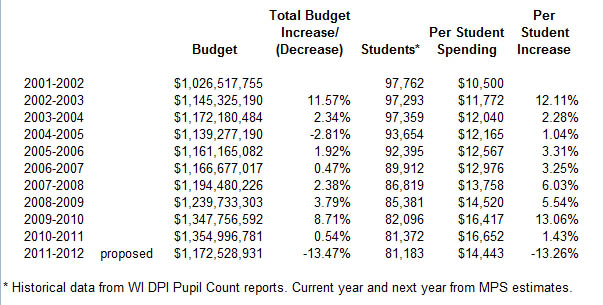I have written plenty about Milwaukee Public Schools and their failure to educate children, despite their out-of-control spending. Teachers and administrators always claim that more money is the answer to all their problems. And the money is for the children!!!
When the poor quality of U.S. education is pointed out, we are frequently told that more should be spent on the government schools. But such claims are fallacious. Since World War II real (inflation-adjusted) spending per student has increased about 40 percent per decade, or about doubled every 20 years (Figure 2).(6)
Figure 2 Inflation-Adjusted Spending on American Schools
Despite all of this spending, students have lower levels of achievement than ever before.
Here are the latest numbers on the MPS historical spending and budget for the next school year:
Spending for next school year is going to go down, but only because Governor Scott Walker has been brave enough to force a change that has been needed for a long time. The last two school years, Milwaukee Public Schools has spent and average of $16,500 per child. That is projected to go down to $14,443 per child next school year but: (a) I’ll believe it when I see it, and (b) that is still a huge amount.
How much are other school districts spending? Check out this table, with states ranked by how much they spend per child. If Milwaukee was a state, its 2008-2009 spending would have put it in 8th place. The spending in the next two years would have put Milwaukee almost at the top. (I realize this isn’t a completely fair comparison, because state data includes rural areas, which often have lower per student spending and therefore lower the state average.)
And those figures might even be lower than the true level of spending. According to this article, school districts like to exclude costs from their calculations. If they included all of the real costs of providing education (without accounting tricks), the per pupil costs would be 25% to 100% higher. Another article reports the same issue with public school reported spending versus actual spending.
Of course, spending is not correlated to results in any way. (Debunking the popular battle cry of the teachers’ unions that more money is needed.)
In Utah, the lowest per-student spending state, 21 percent of schools failed to meet the goals set under that federal education law. In New York, the highest per-student spending state, 38 percent of schools fell short.
And don’t be fooled by the claim that “urban districts” can’t educate children because they have too many other problems. There are urban school districts that are doing quite well with educating children. (I’m not saying there aren’t challenges in an urban school district. There are plenty. Maybe MPS needs to study these successful districts and figure out why those children are able to learn.)
And then there are the private schools. They are the number one piece of proof that more money is not needed in order to educate children. Private schools educate children better at a fraction of the cost of public schools:
In fact, Education Department figures show that the average private elementary school tuition in America is less than $2,500. The average tuition for all private schools, elementary and secondary, is $3,116, or less than half of the cost per pupil in the average public school, $6,857. A survey of private schools in Indianapolis, Jersey City, San Francisco, and Atlanta shows that there are many options available to families with $3,000 to spend on a child’s education. Even more options would no doubt appear if all parents were armed with $3,000 vouchers.
Of course, the educational costs of private schools are not covered by tuition alone. There are supplemental sources of funding, so the total cost of educating children in private schools is higher than the figures cited above. Still, it costs much less to educate a child in the average private school.
So where does all the money go in MPS? I have no idea. The average classroom in MPS accounts for about $500,000 of spending. Check out how I think this money could be spent (starts about halfway down the article). I gave each classroom all kinds of resources and equipment, and still couldn’t spend all the money.






We are a homeschooling family that spent $882.86 per child for the year ending May 31. I don’t believe the “secret ingredient” is money. The “secret ingredient” (in quotes) is commitment to the education, training, and well being of the students. I cannot imagine anyone more committed to my children than my wife and I.
The quoted information is a little bit outdated. The average cost of private elementary schools is from 1996. The current average cost is over $6,000 now. That doesn’t change the point of the write-up, but lowers the perceived gap in cost.
Yes, it’s difficult to find current cost data. There is lots of data regarding private school tuition, but costs, not so much. Cost is the correct figure to compare, since tuition usually doesn’t cover the full cost of providing the information. If anyone can find more current cost information for private schools, please post a link.
[…] claim that they need more money, yet time and again it is demonstrated that the district has been getting more money on a per-student basis, and in spite of the increased funding children are not being taught to read and […]
So you point out a problem, yet pose no solution. What is the purpose of this article other than posturing?
Recognizing a problem is the first step in solving it. But I propose this solution: Take the money out of schools. Get out of the “technology” of education and get back to paper, pencils and teachers who really want to teach. Ensure the teachers have the natural ability to teach (yes, it can be determined). End the union domination of education; they merely stand in the way. Get rid of the “educrats” that permeate the bureaucracy and provide no value. Allow parents to be responsible for their children.
How’s that?
The purpose of the article is to provide information. Thanks for asking!
[…] Read more on school spending here. Related posts: […]
[…] of students in Milwaukee Public Schools has been declining for years. More than ten years ago, the student population in MPS hovered near 100,000. But everyone still talks about it like it is yesterday. The district has had more than 10 years to […]
One reason why public schools are more successful is they can kick out the trouble-makers without much jumping through hoops. Some kids at my children’s high school were caught filming a porn. They were expelled immediately, without even benefit of a school board meeting. Try doing that at a public school.
Yes, costs have gone up over the decades. Why?
1) Since WW II, cities grew. More schools were built. Cities have since declined in size, but school systems are still saddled with expenses for buildings, even if not in use.
2) The growth of pensions and teachers receiving them, and
3) Teachers unions – put in place as a counter to schools firing teachers right before they were eligible for retirement and pensions (prior to age discrimination laws).
4) Health insurance costs have blossomed since the 1970’s, when Nixon’s administration allowed health insurance to be for-profit instead of non-profit.
5) General increase in costs of living, and a general rise in the overall tax burden on all classes. Teachers want to negate that tax bite and are in a better position to do so than most professions.
This is all just crap I’m pulling off the top of my head. I’m sure other reasons exist, but those are the easy ones.
We all understands that costs have gone up over decades. Unfortunately, school systems waste money year after year, and don’t want to be held accountable. They won’t sell the old buildings. They won’t reduce needless administration positions. Don’t be fooled about the unions… they’re not around to stop the discrimination. But they do cost lots of money that districts can’t afford.
But much of what you’re mentioning is related to inflation in general. Yes, costs go up. But the chart above is INFLATION ADJUSTED… meaning that the numbers are adjusted to remove the impact of inflation. This is done to make the numbers comparable from year to year. What you see is that spending (regardless of inflation) has skyrocketed. That’s a problem.